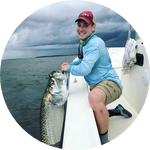Project Results
My research is now published! Once the full version is available, it should be free to view, but if you would like a copy of the early version, place let me know at NoahBressman@gmail.com
Overall, I found that walking catfish use vision and chemoreception to orient on land. They can use the taste buds on their whiskers to find nearby prey through taste. They can also detect attractive compounds from distant bodies of water and move away from noxious compounds while on land using some kind of chemoreception (taste, smell, and/or nociception), but more research is needed to determine the exact mechanism. They also seem to use storm drains to disperse underground, emerging from storm drains during floods. They take advantage of moist ground to disperse overland, eating some wet bugs and worms along the way.
About This Project
I study amphibious fishes, how they move around on land, and where they go while on land. In this study I will travel to southern Florida to run experiments on invasive walking catfish. I hypothesize that this catfish uses visual and chemical cues to navigate on land and migrate to new bodies of water. To test this hypothesis, I will place catfish on land for experiments and expose them to a variety of sensory cues to observe their responses to stimuli.
Ask the Scientists
Join The DiscussionWhat is the context of this research?
One summer, I noticed a live fish in a hallway and asked, "how did it get there?" After a couple of years of research, I figured it out! This fish left a tank in the lab because another fish was trying to eat it, and then went to a spot on the floor where sunlight was shining through a window. The fish used vision to find its way to that spot, and thought the reflection on the tile floor was water. After publishing this research in the Journal of Experimental Zoology, I wanted to figure out how other fishes find their way around on land. Do all fish use the same senses and cues? Or do they navigate land in different ways, depending on their motivation? Currently, not much is known about the behaviors and sensory biology of fish on land.
What is the significance of this project?
Several invasive fish species around the world, like walking catfishes, snakeheads, and climbing perches, are able to move around and survive on land for long periods of time. This gives these fish the potential to quickly increase their invasive range by spreading overland between bodies of water. This project would seek to figure out which senses and sensory cues invasive amphibious fishes use to find their way around on land, and potentially find new bodies of water. In these new bodies of water, these fish can disrupt the ecosystem, endanger native species, and impact fishing and other human activities. By understanding how these fish can spread overland, we could learn how to prevent them from spreading more, or at least help manage the spread of these harmful species.
What are the goals of the project?
The goals of this project are to determine which senses and sensory cues the invasive walking catfish (Clarias batrachus) use to orient and navigate on land and assess their ability to spread to new bodies of water by moving overland. These fish are frequently found on land in southern Florida, particularly while it's raining and/or at night. While placed on land for experiments, the catfish (n = 60) will be exposed to a variety of sensory cues (e.g., reflective surfaces that resemble water, odors associated with water, 3D printed prey, etc.) and observed for responses to stimuli to determine if/how they find water and prey while on land. This project will start January 2019 (when my collaborators will have fish for me), and will include wild observations for natural comparisons.
Budget
I plan on doing field work in Ruskin, FL, where walking catfishes are invasive. To perform experiments on them to figure out how they can spread on land and colonize new bodies of water, I will need funding for housing in the area for 1 month. I will spend most of the days in Ruskin performing experiments, and nights observing and collecting wild catfish. I will also need funding for travel to Ruskin, and to bring my lab equipment with me for the experiments. My home institution, Wake Forest University, has been able to fund my lab equipment needs (like night vision goggles to observe the fish in the wild at night), but I still need additional funding for housing and transportation for my field work. Much of the experimental supplies (3D printed objects, cameras, etc.) have already been purchased using departmental funds for past projects, but some experimental supplies (pieces of fish, odor compounds, etc.) still need funding.
Endorsed by
 Project Timeline
Project Timeline
During the first week of January 2019, I will travel to Ruskin, FL to perform experiments on walking catfish terrestrial orientation and navigation, in collaboration with scientists at the University of Florida. Experiments should take about 3-4 weeks, and then I will return to Wake Forest University at the end of January to analyze my data over the next few months.
Sep 25, 2018
Project Launched
Jan 07, 2019
Travel to University of Florida's Invasive Species Laboratory in Ruskin, FL
Jan 09, 2019
Collect at least 60 walking catfish
Jan 10, 2019
Begin orientation/navigation experiments
Jan 30, 2019
Complete orientation/navigation experiments
Meet the Team
Noah Bressman
Dr. Noah Bressman is a Postdoctoral Research Fellow at Chapman University. He received his PhD from Wake Forest University studying biomechanics, functional morphology, and behavior. More specifically, Noah focuses his studies on amphibious fishes, how they move around on land, how they find their way around on land, and why they go onto land.
Noah has always had a passion for fish since the day he was born, but his experiences with amphibious fishes began the summer after his freshman year of college. While taking a summer marine biology course at Shoals Marine Lab, Noah noticed a 2" fish had escaped from a tank and moved about 10 feet away. He thought this was odd, but put the fish back. The next day, another fish escaped and went to the exact same spot on the tile floor! This couldn't have been a coincidence, so Noah began his investigation. He found out this species of fish, the mummichog (Fundulus heteroclitus), is capable of breathing air to some extent. Using high-speed videos, he was able to describe how they can effectively move around on land using a combination of a jumping and uprighting behaviors.
After getting a grant from the Andrew W. Mellon Foundation, Noah was able to continue this research the next summer, and went on to describe how they can orient and navigate toward water (and other reflective surfaces like foil and tile). He published this research in the Journal of Experimental Zoology, which was publicized on Gizmodo and Discovery Canada's show, Daily Planet.
Noah continues to study the fascinating field of amphibious fishes, and shares research updates on social media at his page: facebook.com/noahcarlfish, and on Instagram and Twitter @NoahwithFish. He also educates the public on fish biology through his biological artwork and the scientific blog that he maintains for the Discovery Channel Show, A Fishing Story.
Miriam Ashley-Ross
Dr. Miriam Ashley-Ross is a professor of biology at Wake Forest University, focusing on functional morphology, biomechanics, and comparative physiology.
Additional Information
There are lots of videos online showing how well walking catfish can move around on land, but it is mostly unknown how and why they go onto land.
Project Backers
- 25Backers
- 100%Funded
- $1,002Total Donations
- $40.08Average Donation



